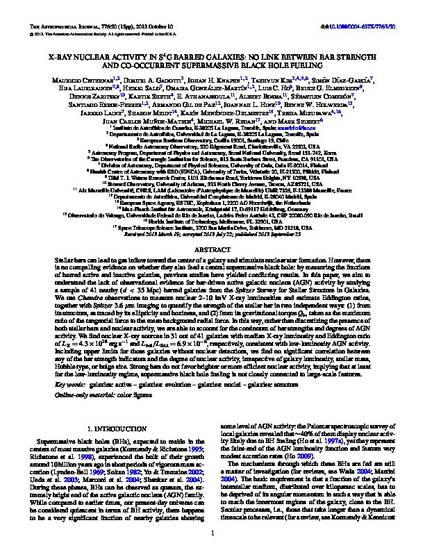
Stellar bars can lead to gas inflow toward the center of a galaxy and stimulate nuclear star formation. However, there is no compelling evidence on whether they also feed a central supermassive black hole: by measuring the fractions of barred active and inactive galaxies, previous studies have yielded conflicting results. In this paper, we aim to understand the lack of observational evidence for bar-driven active galactic nucleus (AGN) activity by studying a sample of 41 nearby (d < 35 Mpc) barred galaxies from the Spitzer Survey for Stellar Structure in Galaxies. We use Chandra observations to measure nuclear 2–10 keV X-ray luminosities and estimate Eddington ratios, together with Spitzer 3.6 μm imaging to quantify the strength of the stellar bar in two independent ways: (1) from its structure, as traced by its ellipticity and boxiness, and (2) from its gravitational torque Qb, taken as the maximum ratio of the tangential force to the mean background radial force. In this way, rather than discretizing the presence of both stellar bars and nuclear activity, we are able to account for the continuum of bar strengths and degrees of AGN activity. We find nuclear X-ray sources in 31 out of 41 galaxies with median X-ray luminosity and Eddington ratio of LX = 4.3×1038 erg s−1 and Lbol/LEdd = 6.9×10−6, respectively, consistent with low-luminosity AGN activity. Including upper limits for those galaxies without nuclear detections, we find no significant correlation between any of the bar strength indicators and the degree of nuclear activity, irrespective of galaxy luminosity, stellar mass, Hubble type, or bulge size. Strong bars do not favor brighter or more efficient nuclear activity, implying that at least for the low-luminosity regime, supermassive black hole fueling is not closely connected to large-scale features.
Cisternas, Mauricio, et al. "X-Ray Nuclear Activity in S4G Barred Galaxies: No Link Between Bar Strength and Co-Occurrent Supermassive Black Hole Fueling." 2013. The Astrophysical Journal 776(1): 15 pp.

Copyright 2013. The American Astronomical Society. All rights reserved.
https://doi.org/10.1088/0004-637X/776/1/50